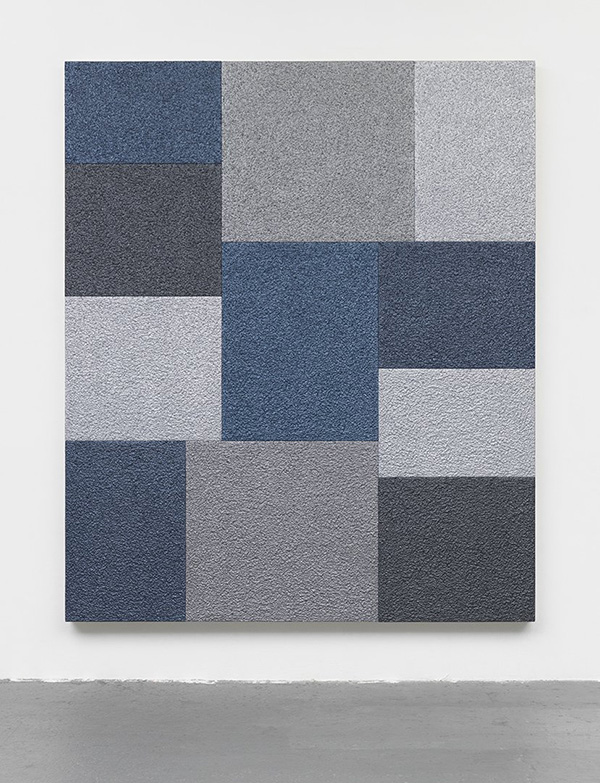ART CITIES:Moscow-Peter Halley
 Peter Halley began his formal training at Phillips Academy in Andover, Massachusetts, from which he graduated in 1971. During that time, Halley read Josef Albers’s “Interaction of Color” (1981), which would influence him throughout his career. His paintings are diagrams of the lived experience in a contemporary urban environment, in which social space is ever more divided and geometrised but individuals remain connected via ‘conduits’ of information flows, roadways and electrical grids.
Peter Halley began his formal training at Phillips Academy in Andover, Massachusetts, from which he graduated in 1971. During that time, Halley read Josef Albers’s “Interaction of Color” (1981), which would influence him throughout his career. His paintings are diagrams of the lived experience in a contemporary urban environment, in which social space is ever more divided and geometrised but individuals remain connected via ‘conduits’ of information flows, roadways and electrical grids.
By Efi Michalarou
Photo: Gary Tatintsian Gallery Archive
An exhibition with works of Peter Halley is on presentation at Gary Tatintsian Gallery in Moscow. Peter Halley developed a simple vocabulary of architectural icons that he labeled “Prisons” and “Cells” linked with straight lines labeled “Conduits”. Through this simple vocabulary, he sought to express the regimentation of the spaces we inhabit, how they are formed by forces beyond our control. In 1981 he started to use fluorescent Day Glo paint, the eerie glow of which mimicked the light of the recently introduced LED screen, and Roll-a-Tex, a powdered paint additive used to create the “Popcorn” textured interior wall treatments that were ubiquitous in newly built suburban condos of the time. Halley’s formal experimentation throughout the decade was driven by the tension between his use of purist geometric form and his embrace of these commercial materials. Peter Halley came to prominence as an artist in the mid-‘80s, as part of the generation of artists that first exhibited in East Village, including Jeff Koons, Haim Steinbach, Mayier Vaisman and Ashley Bickerton. These artists became identified on a wider scale with the labels “Neo-Geo” and “Neo-Conceptualism”. Neo-conceptualists used irony and pastiche to subvert and comment upon structural issues of the time; they drew from Conceptual Art to create paintings and sculptures that operated as a set of pictorial signs referencing artists and moments in postwar art history. Halley’s philosophy becomes the basis for the Neo- conceptualism (Neo-Geo) movement. His works are a critical analysis of the mechanization and commercialization of the modern world. Seeing the metaphor of our society, Halley makes descriptions of social landscape, human isolation and connectivity in his works. Simple diagram structures in his paintings become a means of dramatizing political and social life. While developing his visual language, Halley became interested in French post-structuralist writers, including Jean Baudrillard, Guy Debord, Michel Foucault, and Paul Virillio, all of whom shared his concern with the character of social spaces in a post-industrial society. In 1981, he published his first essay “Beat, Minimalism, New Wave, and Robert Smithson” in Arts, a New York–based magazine that would publish eight of his essays before the decade’s end. “Notes on the Paintings” (1982), decodes the formal language of his own early work, while his seminal essay, “The Crisis in Geometry” (1984), examines the work of such artists as Alice Aycock, Robert Morris, Jeff Koons, and Sherrie Levine through the contrasting ideas of Michel Foucault and Jean Baudrillard. The two later essays, “The Deployment of the Geometric” (1986) and “Notes on Abstraction” (1987) describe a world transformed into a site of alienation through the growing power of simulation. In the 1990s, Halley started to produce site-specific installations for museums, galleries, and public spaces that would interact with the surrounding architecture. His installations mix imagery and media such as painting, fiberglass relief sculpture, wall-size flowcharts, and digitally generated wallpaper.
Info: Gary Tatintsian Gallery, Serebryanicheskaya Naberezhnaya 19, Moscow, Duration: 24/6-10/9/17, Days & Hours: Tue-Fri 12:00-20:00, Sat 12:00-18:00, www.tatintsian.com




